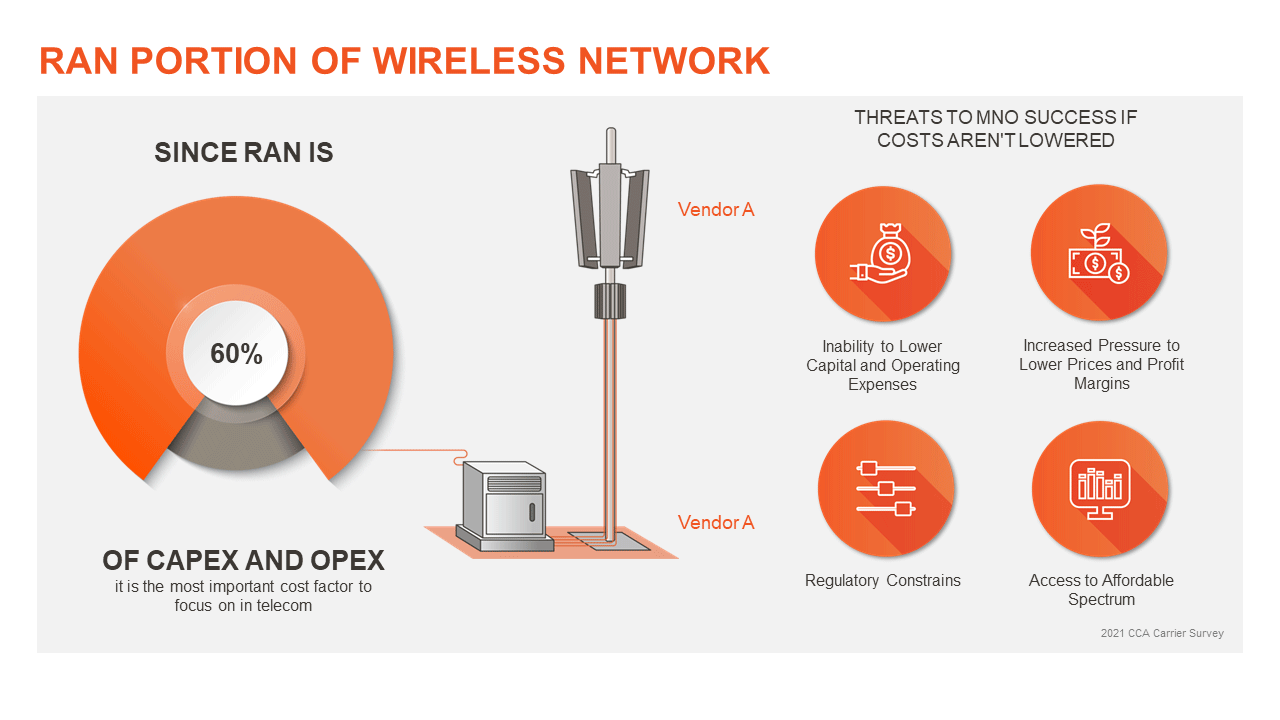Reducing Total Cost of Ownership (TCO) with Open RAN
As MNOs face rising costs of operating their networks, the move toward 5G network architecture and services is a key driver for Open RAN. This is because Open RAN networks enable MNOs to reduce their Total Cost of Ownership (TCO) while supporting a smooth migration path to 5G. Let’s take a look at how Open RAN networks compare to legacy and what is driving the movement toward Open RAN.
Legacy and Open RAN Networks
Legacy networks typically involve a single vendor dominating both the solution hardware and software in any given network. Virtualization is the disaggregation of hardware and software but with proprietary interfaces. While virtualization is a step in the right direction, it doesn’t provide the same flexibility of choice and cost savings that come with the Open RAN promise.
In contrast to legacy, Open RAN networks are a subgroup of virtualized Radio Access Network (RAN), with open interfaces. Open RAN networks are all about open, generic, predefined interfaces between each building block within the RAN ecosystem of RU, DU, CU, and RIC. Open RAN networks provide the ability to mix and match components from different vendors, therefore providing more cost-effective solutions.
One of the key drivers for Open RAN is the move toward 5G network architecture and services. Current legacy network design cannot scale in terms of performance and cost in the way that is needed to support actual market demands.
Since Open RAN is all about bringing a new way of thinking into the market, let’s look at the entire lifecycle from design through development, keeping in mind that installation and ongoing support are just as important – if not more so – than other aspects of the network.

Reducing TCO with Automation
Parallel Wireless has found that the RAN is at least 60% of any cellular network’s Total Cost of Ownership (TCO) when combining Capital Expenses (CAPEX) and Operating Expenses (OPEX) together. Sometimes it could be even more, depending on each individual network.
When trying to analyze which part of the overall cost is more critical, OPEX is around 70% of the TCO value, and CAPEX is around 30%. This means that everything MNOs deploy as part of the RAN has at least two important aspects that need constant review: first, the deployment cost itself, and second, ongoing operational cost and the implications on the overall network. Deployment cost, although important, is not the most important contributor to the overall TCO estimation when looking at OPEX over a five-year period. Considering its high proportion of TCO value, reducing OPEX is key for long-term profitability.
Automation is one of the main tools that affects mainly OPEX and lowers overall TCO spending across different phases of the network lifecycle.
There are approximately four areas where automation has a direct positive impact on TCO:
- Building datacenter capabilities that support Network Function Virtualization (NFV) is the first phase of building a network and making sure it is ready for a future automated process. The first priority is setting up a scalable virtual environment with cloud-native network functions to easily scale services from basic to advanced.
- ZTP (Zero Touch Provisioning) helps ensure that any automation will be as autonomous as possible with minimal user intervention beyond basic definitions and rules.
- CI/CD (Continuous Integration and Continuous Delivery/Deployment) is purely focused on ongoing network operation and. Successful “CI” means new code changes to an app are regularly built, tested, and merged to a shared repository, significantly simplifying the development process. Successful “CD” is about automating additional stages of delivery and deployment. Continuous delivery means that changes to an application are automatically bug tested and uploaded to a shared repository where they can be deployed to a live production environment by the operations team. Continuous deployment means that released software updates/versions from a shared repository can be deployed to production with minimal delays.
- Optimization is the last phase in the deployed network lifecycle, and it directly affects OPEX costs since it deals with remote site/network optimization. Until the introduction of automation, this task was conducted manually by multiple teams – each team having expertise in certain domains and requiring extensive travel and manual labor. Now that this phase utilizes automation, it means not only that it will be done at a fraction of the cost but, more importantly, it will be done more quickly. This enables the network to react much faster to changes while optimizing shared resources and potential savings.
How Operators Have Realized Cost Savings with Open RAN
Operators worldwide who are early adopters of Open RAN have benefited from open interfaces. Some have enjoyed single RAN consolidation benefits, which lowered the amount of equipment needed to provide their desired level of service. Usually, these operators have compared their current deployments to older 4G legacy implementations and noticed a clear advantage. Some operators leverage the lower deployment costs, while some enjoy multi-Radio Access Technology (RAT) capabilities that enable them to renew and refresh their networks while maintaining legacy services, as well as adding new 4G and 5G services using the same equipment and infrastructure.
To learn more about how Parallel Wireless can help reduce network TCO, contact us today.
Resources:
The Power of Automation and Open RAN
Parallel Wireless Announces Industry Leading Open RAN Ecosystem at MWC21 Barcelona